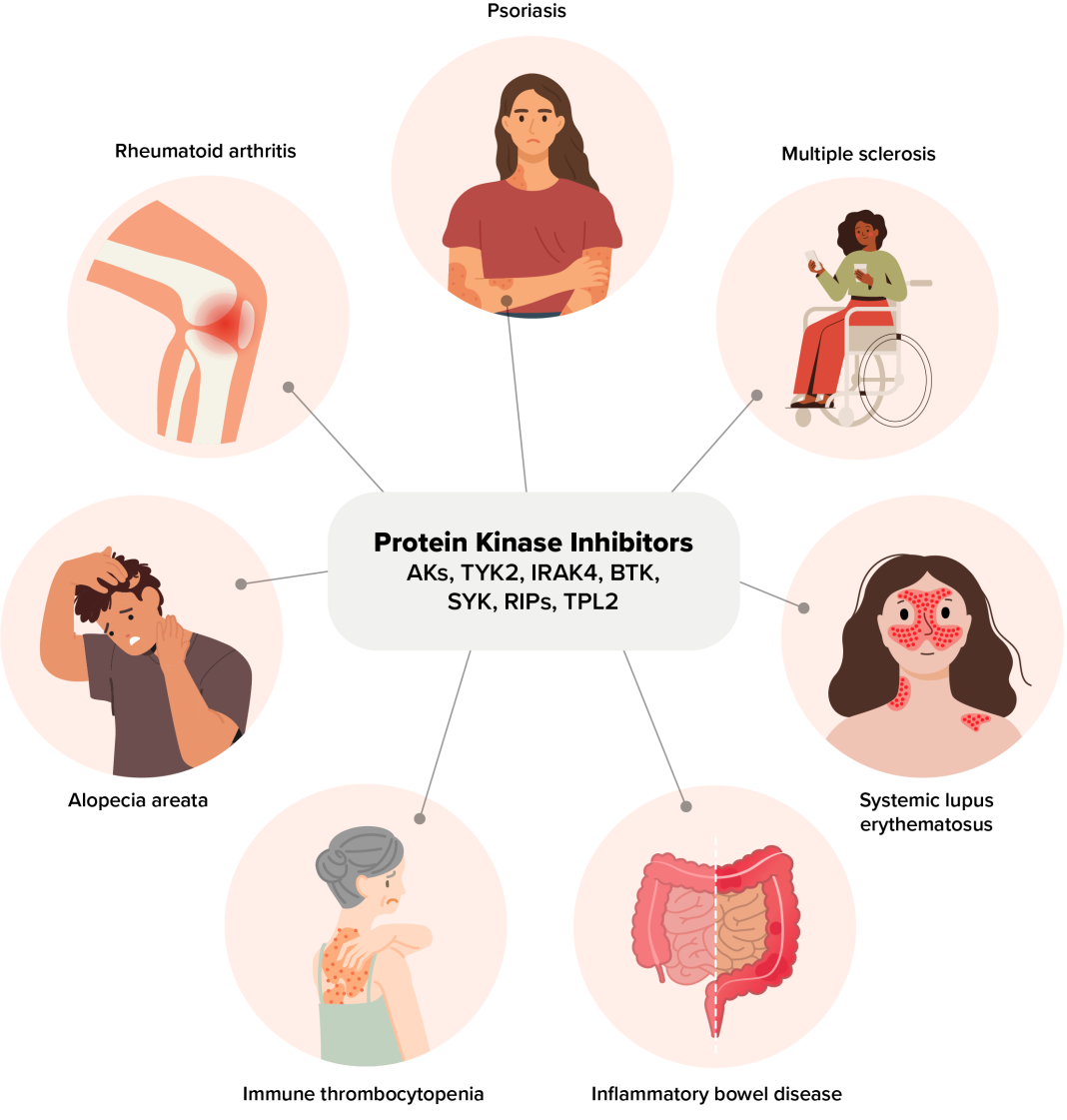Julie Blaising, Discovery Project Leader in Immunology at F. Hoffmann-La Roche Ltd, tells us why protein kinases are an effective target for treating many chronic inflammatory disorders
Kinases are enzymes responsible for protein phosphorylation. The human kinome consists of about 518 protein kinases and is classified according to the amino acid residue that it phosphorylates. (1) Kinases are expressed in many cell types and are involved in cell signaling, which leads to key physiological processes such as cell growth, proliferation, metabolism, and regulation of immune responses. (1, 2) Due to their central role in cellular processes, they are also associated with many diseases.
Kinase inhibitors were first introduced to combat cancer. Further progress in drug discovery, e.g., with regard to selectivity, allosteric MoA, etc., allowed for an expansion toward other indications, such as inflammatory diseases.
Protein kinases and immunity
Immune cells express different classes of receptors (T cell receptors (TCRs), B cell receptors (BCRs), Fc receptors (FcRs), cytokines receptors, …) that use phosphorylation to initiate the first step of activation in their signaling.
- Janus Kinases (JAKs) transduce signals from many cytokine receptors of the interleukin and interferon families as well as from growth hormone and erythropoietin. (1, 2)
- IL-1R-associated kinases (IRAKs) are involved in Toll-like receptors (TLRs) and IL-1R signals (2). Additionally, IRAKs play key roles in other biologically relevant responses, such as inflammasome formation and immunometabolism. (1)
- Receptor-interacting protein kinases (RIPKs) are critical regulators of cell death and inflammation with important roles in the maintenance of tissue homeostasis. They are involved in signaling the tumor necrosis factor (TNF). (1)
- Interleukin-2 inducible T-cell kinase (ITK) and Bruton’s tyrosine kinase (BTK) are involved in antigen receptor (TCR/BCR), TLR, and FcR signaling. (1, 2)
- Spleen tyrosine kinase (SYK) is an Src family member essential in FcR and BCR signaling and functions in parallel to its homolog, tyrosine-protein kinase Zap70, in TCR signaling. (1, 2)
- MAPKs are a highly conserved family of serine/threonine protein kinases that are induced in response to stress and inflammation and regulate proliferation, differentiation, survival, apoptosis, and other cellular processes. MAPKs are downstream of several immune and cytokine receptors, such as TLRs, IL-1R, TNFR, CSF1R, and IL-17R, as well as growth receptors, such as EGF, FGF, and VEGF. (1)
- TANK-binding kinase 1 (TBK1) and IKKε are two serine/threonine protein kinases involved in the activation pathway of type I interferon genes and interferon-stimulated genes (ISGs). (1)
- NF-κB-inducing kinase (NIK) is an integral component of non-canonical NF-κB signaling and is found downstream of a subset of TNFR superfamily members. (1)
- The salt-inducible kinases (SIKs) SIK1, SIK2, and SIK3 belong to the adenosine monophosphate-activated protein kinase (AMPK) family of serine/threonine kinases and are involved in proinflammatory macrophages regulation. (3)
As described, protein kinases are involved in multiple signaling cascades in immune cells and constitute a central node for mediating inflammation.
Therapeutic potential of protein Kinases to treat chronic inflammation
Overall more than 40 kinase inhibitors are currently being studied in humans for immune mediated diseases such as rheumatoid arthritis, inflammatory bowel disease, psoriasis, systemic lupus erythematosus, multiple sclerosis, immune thrombocytopenia and alopecia areata,…. This last decade, tremendous progress has been made and several kinase inhibitor drugs were approved for inflammatory diseases. Among these are inhibitors of JAKs (Tofacitinib for rheumatoid arthritis (RA), Ulcerative Colitis (UC), psoriatic arthritis (PsA), ankylosing spondylitis (AS), juvenile idiopathic arthritis (JIA); Ruxolitinib for graft versus host disease (GVHD), atopic dermatitis (AD) (topical only), vitiligo (topical only); Upadacitinib for RA, PsA, AD, AS, UC; …); inhibitors of TYK2 (Deucravacitinib for Psoriasis), inhibitors of BTK (Ibrutinib for GVHD), and SYK (Fostamatinib for ITP, idiopathic thrombocytopenia (ITP)).
Some kinases have selective expression in immune cells, but many kinases are broadly expressed, and this can constitute a challenge in terms of safety. In addition, because many kinases induced during inflammation also regulate non-inflammatory pathways, kinase inhibition may also result in unknown on-target effects.
Therefore, selectivity, level of inhibition/ suppression, and modalities to deliver the drug directly to the target organ are deemed essential to promote beneficial therapeutic responses while avoiding side effects.
Future perspectives for protein kinases
As discussed in this article, protein kinases are an attractive target for many chronic inflammatory disorders. Due to their broad expression on different cell types and their role in critical physiology processes, safety is one of the main challenges for the development of kinase inhibitors to treat chronic inflammatory diseases. Therefore, a comprehensive understanding of signaling kinases combined with ongoing clinical evaluations should help to improve the discovery of effective therapies.
References
- Castelo-Soccio L, Kim H, Gadina M, Schwartzberg PL, Laurence A, O’Shea JJ. Protein kinases: drug targets for immunological disorders. Nat Rev Immunol. 2023 Dec;23(12):787-806. doi: 10.1038/s41577-023-00877-7. Epub 2023 May 15. Erratum in: Nat Rev Immunol. 2024 Jan;24(1):79. PMID: 37188939; PMCID: PMC10184645.
- Zarrin AA, Bao K, Lupardus P, Vucic D. Kinase inhibition in autoimmunity and inflammation. Nat Rev Drug Discov. 2021 Jan;20(1):39-63. doi: 10.1038/s41573-020-0082-8. Epub 2020 Oct 19. PMID: 33077936; PMCID: PMC7569567.
- Jagannath A, Taylor L, Ru Y, Wakaf Z, Akpobaro K, Vasudevan S, Foster RG. The multiple roles of salt-inducible kinases in regulating physiology. Physiol Rev. 2023 Jul 1;103(3):2231-2269. doi: 10.1152/physrev.00023.2022. Epub 2023 Feb 2. PMID: 36731029; PMCID: PMC10190946.

This work is licensed under Creative Commons Attribution-NonCommercial-NoDerivatives 4.0 International.


